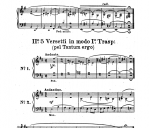What does "Versetti in Modo I Trasp: pel Tantum Ergo" mean?
-
This is from a little book of music for Benediction by Oreste Ravanello. I find these handy to play as the priest and servers come in for Benediction, but the booklet has a Prelude which is probably meant for that (and for a bigger church). I asked a few people but they couldn't figure out what Trasp signified.
I attach a screenshot for a little more context.
The work is at https://imslp.org/wiki/Easy_Pieces%2C_Op.99_(Ravanello%2C_Oreste)
 Screenshot_2019-02-20_07-51-28.png729 x 621 - 194K
Screenshot_2019-02-20_07-51-28.png729 x 621 - 194K -
Five little verses in Mode I Transposed
Linguistically, I have no clue what "pel" means but my brain wants to assume that it's a mistake for "per" or "for the tantum ergo" ... or perhaps "based on" ... not sure.
Thanked by 1CHGiffen -
Could be per il Tantum Ergo (in older Italian it was common to combine certain words with the article after. (per il = pel; con il = col; etc.)
I could be totally wrong here; this is just a guess.Thanked by 1cmb -
Yes, per + il sounds plausible. They're all written in the key of D major, so not sure how "Transposed" relates.
As written it feels like it leads in well to playing Tantum Ergo in C major (starting note E). Though the key sig is D, they all finish on E-ish chords. Hmmm, is my lack of music theory training showing?
In another book they had verses "Translatus ad quintam inferior" so maybe Gregorian chant was considered to have an absolute pitch at one time??? Though universal tuning probably wasn't a thing - the Translatus quote comes from a 1645 book and the Trasp from 1911.
Maybe the moral is to use it where it's useful and not stress about the details.Thanked by 1PaxTecum -
…in the key of D major… Tantum Ergo in C major (starting note E)
Usually called E-Dorian and Mode III, respectively. -
With two sharps in the key signature, Mode I, whose final is on Re, would have its final on E ... hence the "E-ish" chords. There is indeed a Mode I Pange lingua gloriosi (for the Procession after the Communion on Corpus Christi) which has a quite beautiful melody that moves somewhat like but not exactly as the usual Mode III melody does. "Transposed" presumably refers to the transposition up a whole step (hence the two sharps in the key signature).
-
There is indeed a Mode I Pange lingua gloriosi (for the Procession after the Communion on Corpus Christi) which has a quite beautiful melody that moves somewhat like but not exactly as the usual Mode III melody does.
The mode I melody, is sometime subtitled "Apud Italos usitatum" and is found in most books even the Graduale Romanum (1924 ed.). I am told this Mode I melody is a version used in pre-reformation England.Thanked by 1CHGiffen -
Thanks - singing through the Mode 1 melody, it does have similarities. It all makes sense now, plus I have another Tantum Ergo tune to familiarise myself with.Thanked by 1CHGiffen
-
Here's a link to the thread that has my setting of the Mode I Pange lingua gloriosi (as well as my setting of the Mode III Tantum ergo sacramentum).Thanked by 1Incardination
Welcome to the MusicaSacra Forum!
To participate in the discussions on Catholic church music, sign in or register as a forum member, The forum is a project of the Church Music Association of America.
Categories
- All Discussions21,104
- General Music Discussion8,217
- Job Openings197
- Management of Music Programs850
- Choral Matters533
- Church Documents and Rubrics524
- CMAA Notes302
- Events716
- For Newcomers: Read First26
- Sacred Polyphony546
- Hymnody872
- Gregorian Chant: General2,697
- ↳ Graduale Romanum and Liber Usualis368
- ↳ Graduale Simplex60
- ↳ Semiology63
- Vernacular Plainsong696
- Anglican Use and Anglican Chant68
- Organ, Other Instruments and Repertoire435
- New Composition/Works in Progress1,290
- Recordings230
- Music for Hispanic Ministry159
- Music Education: Children211
- Music Education: General222
- News Items245
- Positions Wanted2
- General Discussion: Catholicism739
- Amusements177
- General Discussion1,033
- Opinions117



